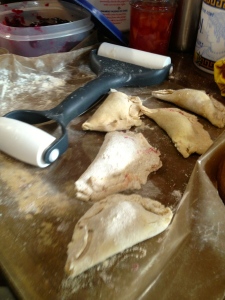 All cranberry chutneys that are safe to can seem the same to me. There are more interesting recipes in, say, my Ball Blue Book from 1942, and in Indian cooking forums online, but nothing in any of the canning books that I finds different enough to use as that subversive flavorbomb.
All cranberry chutneys that are safe to can seem the same to me. There are more interesting recipes in, say, my Ball Blue Book from 1942, and in Indian cooking forums online, but nothing in any of the canning books that I finds different enough to use as that subversive flavorbomb.
So I modified one. This is a perfectly safe slight modification of the USDA-approved canning recipe for cranberry chutney. The sugar and vinegar amounts need to remain the same, but you might add some lemon zest or orange peel, if you like, or substitute all raisins or apricots for the half-and-half dried fruit mixture. Make it yours. Give it as gifts throughout the holiday season.
The pictures above and below are not cranberry chutney. Cranberry chutney always looks the same. Instead, they are from the Laughing Stock Farm turkey kill day, where I worked slinging pancetta bacon and crêpes for customers this year with my friend Del, the charcutier. Some of that cheese is his, and some the other cheesemaker, Susan’s. The turnovers were filled with cranberry filling and baked in the clay oven in the barn.
The whole day was a blast and I want to do it again. Folks can participate in that very important and emotionally difficult process of slaughtering their own meat, and learning about the steps that go into humane and efficient processing of the bird. I’m growing more and more awed by the sacred process of taking a life for human consumption. I’m sure I’m going to write more about it.




 But for now, cranberry chutney. Tart, acidic, spiced, tangy cranberry chutney. I pulse the dried fruit and mince the onions finely so they remain small, and I don’t cook the cranberries down enough to make a real sauce, since I want to be able to see the berries. I also add mustard seed and a chopped up Asian pear for texture. The latter raises the pH just a tad, but the chutney is so acidic with the cranberries, grapefruit juice, and vinegar, I’m not too worried. If you are, leave it out.
But for now, cranberry chutney. Tart, acidic, spiced, tangy cranberry chutney. I pulse the dried fruit and mince the onions finely so they remain small, and I don’t cook the cranberries down enough to make a real sauce, since I want to be able to see the berries. I also add mustard seed and a chopped up Asian pear for texture. The latter raises the pH just a tad, but the chutney is so acidic with the cranberries, grapefruit juice, and vinegar, I’m not too worried. If you are, leave it out.
Yes, you’re that kind of girl, the one who isn’t allowed to change Thanksgiving, but sends subversive operatives in to flavorbomb that mess around. This is your recipe.
(P.S. For the rest of youse: need a recipe for the best cranberry sauce EVER?)
Cranberry Chutney for the Thanksgiving Rebel
Makes 9-10 half pints.
- 8 cups (about 32 oz. weight) cranberries
- 2 cups white sugar
- 2 cups lightly packed light brown sugar
- 2 cups cider vinegar (5%)
- 1 cup cranberry juice or grapefruit juice
- 1 Asian pear, chopped into small pieces
- 3 sticks cinnamon
- 1 tablespoon yellow mustard seed
- 2 cups minced white onion
- 1 cup golden raisins
- 1 cup dried cherries (or Craisins)
- piece of fresh ginger, about 3 inches by 2 inches, peeled and coarsely chopped
- dried chile flakes or Hell Dust smoked chile flakes (optional)
Wash your jars, rings, and lids, and heat the lids according to the package instructions as you’re heating up the waterbath canner.
Wash and pick over cranberries. Place in stockpot with sugar, vinegar, juice, Asian pear, mustard seed, and cinnamon. Bring to boil and then simmer for about 15 minutes. Meanwhile, mince the onion and add to pot. Pulse the raisins, cherries, and ginger in the food processor until in small bits. Add to pot with chile flakes, if using.
Stirring very frequently, cook until cranberries are soft and some are bursting, but chutney is not turned into sauce, perhaps 10 minutes more.
Remove from heat and let sit for a couple minutes. Skim foam from top, if necessary. Spoon the hot chutney into jars carefully to reduce bubbles, leaving 1/2-inch head space. Wipe rims of jars and adjust lids and rings. Process in a waterbath canner for 10 minutes.
Note: chutney is best if you let the flavors develop for a few days. You may also choose to freeze it instead of canning it.




You must be logged in to post a comment.